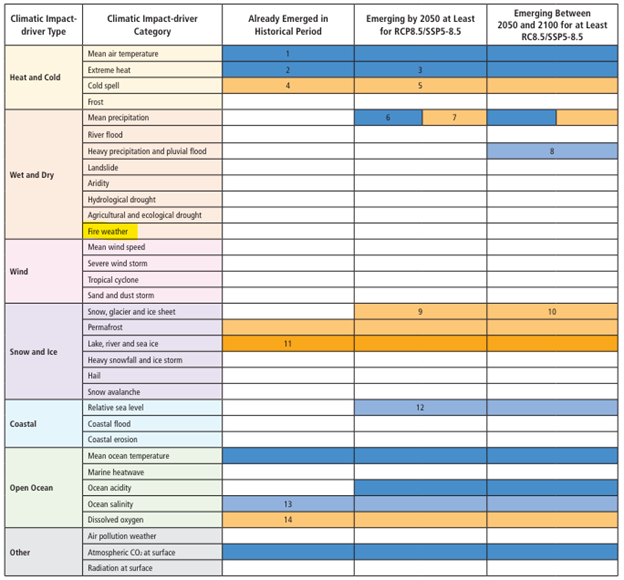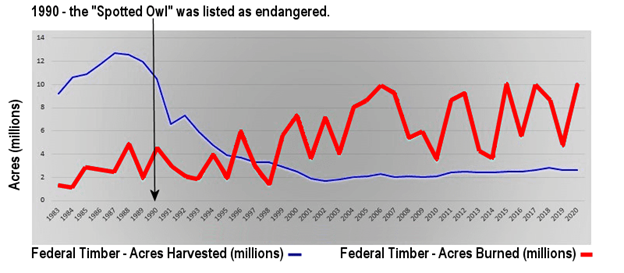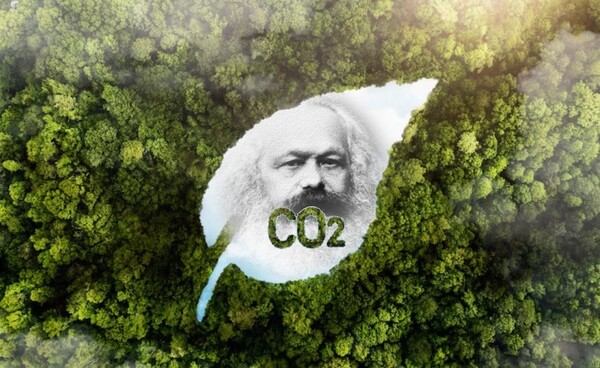his week a new study was published in the Nature journal Ecology and Evolution titled “Increasing frequency and intensity of the most extreme wildfires on Earth.” The study claims that wildfires are on the increase due to climate change. Predictably, the mainstream media jumped all over this with headlines similar to what you see above from CBS News. However, the paper is untrue as it is self-falsifying because it doesn’t even use the minimum 30 year period required for a climatic data comparison. Further, the claims are not supported by science in other sources of data, and other publications.
First, the study itself says it only uses 21 years worth of satellite data, saying:
Climate change is exacerbating wildfire conditions, but evidence is lacking for global trends in extreme fire activity itself. Here we identify energetically extreme wildfire events by calculating daily clusters of summed fire radiative power using 21 years of satellite data…
A minimum of 30 years of data is needed before it can be called a climate comparison. This has been defined for decades. The World Meteorological Organization (WMO) defines climate as “…the average weather conditions for a particular location and over a long period of time.” To create a climate record, 30 years of weather data is averaged to create a “normal” climate expectation for a location or region.
Second, we can turn to the Intergovernmental Panel on Climate Change (IPCC) Who has examined the issue of fire weather as it pertains to increasing wildfire risk. They conclude that had has not even emerged as a signal from climate change and it’s not likely to emerge in the 21st century.
The IPCC also identifies when it expects that the “emergence” of a signal of climate change will be detectable for various impact “climate impact drivers.” Note that table below, with “fire weather” highlighted in yellow. Most people will likely be surprised by the amount of white cells in the table — indicating a lack of signal emergence, even out to 2100. For “fire weather” a signal does not emerge through 2100. It isn’t even seen in the present.

Clearly, the IPCC does not see any connection whatsoever between climate and wildfires, nor does it expect a connection in the coming decades.
Next, we can examine other satellite data, such as this chart below that combines recent satellite data with historical data.

Clearly the trend is sharply down for the area burned. However the study cited by CBS News and others also makes the claim that the intensity of fires is on the increase. There is a simple explanation for this; increased fuel load makes bigger fires.
Increasing forest biomass, also known as “fuel load,” has been prevalent due to forest management issues. Fuel loads also figure greatly in wildfire potential, intensity, and spread.
For example, in the Western United States in 1990, the spotted owl was listed as endangered. As a result, the western logging industry and the associated forest management practices essentially evaporated. As seen in the figure below, data suggests the protected owl habitat has directly caused an increase in forest fuel load (and increased acreage burned) in the absence of effective forest management post 1990.
Fire science tells us increasing fuel load directly correlates with greater fire intensity and rate of spread, plus increasing the acreage burned. Fuel loads can increase fire intensity, as more fuel available to burn means more energy is released as heat. A 2013 study in the International Journal of Wildland Fire found that fire intensity increased with fuel loading. In the Figure 2 below, fire burned area increased due to the protectionism of the spotted owl and other forest species in the Western United States.

Unsurprisingly, the study lists the Western United States as the worst are for “most extreme wildfires” in its Figure 1, seen below circled in red:

So, while their data does support that some of the most extreme wildfires have occurred in the Western United States during the last 21 years is a clear case of correlation is not causation. Attempting to blame climate change simply because fire intensity has increased instead of the problem with fuel loads getting bigger in that area is the fatal mistake the researchers made in addition to the 21 years of data falling short of the 30 years needed to make a climate comparison.
Of course, the mainstream media does not have reporters with the science education needed to even question this. But, as illustrated in this article, you don’t have to be a forest scientist to be able to find this contrary data. It simply appears that the mainstream media didn’t bother to look because they prefer to push a scary narrative about climate change rather than do the job they have been charged with. So much for “journalistic integrity.”






purchase meloxicam online cheap – relieve pain buy generic mobic for sale
warfarin online – https://coumamide.com/ buy cheap cozaar
Hi, I do think this is a great site. I stumbledupon it 😉 I may revisit
yet again since i have bookmarked it. Money and freedom
is the greatest way to change, may you be rich and continue to guide other
people.
my homepage; eharmony special coupon code 2025
nexium 20mg usa – nexium to us buy nexium pills for sale
augmentin 625mg brand – atbioinfo.com acillin uk
order zithromax 500mg online cheap – bystolic 20mg oral nebivolol pills
amoxicillin for sale online – cost combivent ipratropium 100mcg price
buy propranolol sale – buy methotrexate without a prescription order methotrexate 5mg pills
brand motilium – buy domperidone 10mg online buy cyclobenzaprine sale
where can i buy semaglutide – buy generic rybelsus for sale periactin 4 mg generic
azithromycin 250mg cheap – buy floxin medication metronidazole 400mg cheap
More posts like this would add up to the online time more useful.
This is a question which is near to my callousness… Numberless thanks! Unerringly where can I find the connection details in the course of questions?
how to get clomid clomid 50mg for sale cost of cheap clomiphene for sale buy generic clomiphene without dr prescription how to buy clomid no prescription can i buy cheap clomiphene without dr prescription can i get cheap clomiphene
nordvpn coupon code 350fairfax
Pretty section of content. I just stumbled upon your site and in accession capital to assert that
I acquire actually enjoyed account your blog posts.
Anyway I’ll be subscribing to your feeds and even I achievement you access
consistently rapidly.
Today, while I was at work, my cousin stole my apple ipad and tested to see if it can survive a 25 foot drop, just so
she can be a youtube sensation. My apple ipad is now broken and she has 83 views.
I know this is entirely off topic but I had to share it with someone!
Also visit my homepage: nordvpn coupons inspiresensation [tinyurl.com]
I’m no longer sure where you’re getting your info, but great topic.
I must spend some time studying more or figuring out more. Thank you for magnificent info I used to be
in search of this information for my mission.
Check out my blog … nordvpn coupons inspiresensation (da.gd)
Howdy are using WordPress for your site platform?
I’m new to the blog world but I’m trying to get started and create my own. Do you require any html coding
knowledge to make your own blog? Any help would be really appreciated!
Feel free to visit my homepage nordvpn coupons inspiresensation
I am genuinely grateful to the holder of this web site
who has shared this great article at here.
My blog post :: nordvpn coupons inspiresensation (tinyurl.com)